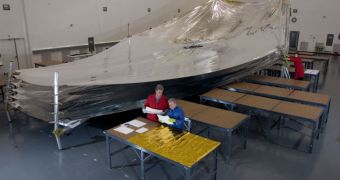When completed, the James Webb Space Telescope will be the most complex space observatory ever built, and ensuring that this will happen on time is a new Mission Systems Engineering team.
The group is made up of experts at Northrop Grumman, the main contractor the American space agency selected for this project, and the NASA Goddard Space Flight Center (GSFC), in Greenbelt, Maryland.
The new team will be led by experts at the GSFC James Webb Space Telescope Project Office. This facility is charge of integrating all the systems that will fly on the impressive telescope.
Experts at both NASA and Northrop decided to integrate their capabilities using this approach after the successful Mission Critical Design review test that the JWST passed this April.
The integrated, consolidated and “badgeless” group will optimize access to the corporation's system engineers during the telescope's critical test and verification phase that is currently underway.
“Northrop Grumman's system engineering expertise will be integrated with NASA Goddard's mission-level system engineering decision-making so we can better manage and streamline the complex integration and test phase of the telescope,” says NASA official Rob Strain.
The expert holds an appointment as the Space Flight Center Director at the GSFC. He adds that Northrop's support is a critical part of systems engineering decisions that will be made at NASA.
“We look forward to continuing our close relationship with NASA in this new streamlined organization,” adds the vice president and general manager of Northrop Grumman Aerospace Systems, Dave DiCarlo.
“This evolution will enable the entire project to maximize efficiencies and reduce costs so we can meet our goal of launching the Webb telescope earliest with the least risk,” he adds, quoted by SpaceRef.
The JWST is scheduled for launch in a couple of years, and it will become the American space agency's main eye-in-the-sky. When deployed, it will be the most advanced, complex and sensitive machine ever built.
NASA's next main observatory will need to be able to withstand harsh temperature swings, which may sometimes amount to as much as 200 degrees Fahrenheit within a single day.
Additionally, the instrument will also need to be able to withstand micro-meteor impacts, and as well as intense exposure to solar radiation. Once out of Earth's atmosphere, it will have no other protective layers than the one it carries.
Moreover, the JWST will need to endure the harsh conditions of a rocket launch, when it will pull many Gs, and be subjected to violent trepidations.
Its instrument needs to be constructed in such a manner that all of its sensitive, high-tech instruments can make it to orbit in one piece.
This is very difficult to do, considering that the cameras and mirrors that will go on the JWST will be oriented on sensitivity, and not strength.

 14 DAY TRIAL //
14 DAY TRIAL //